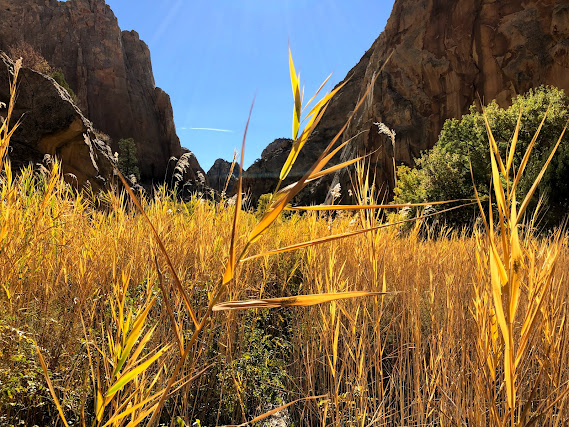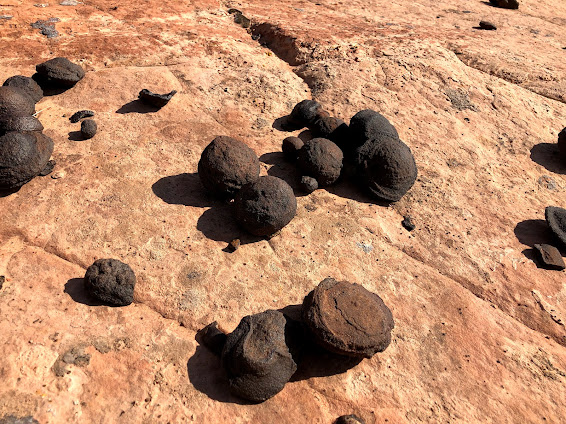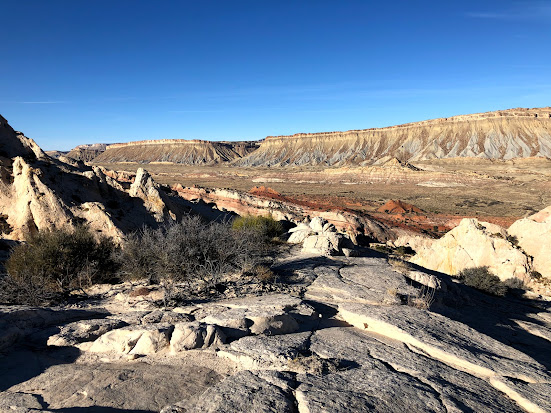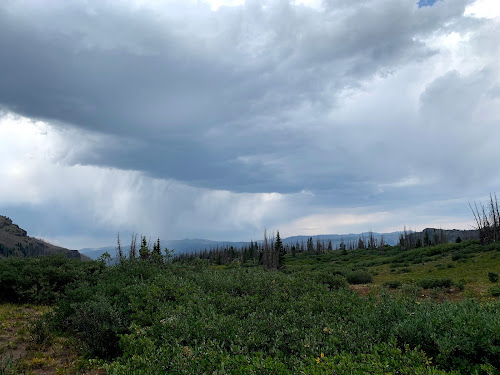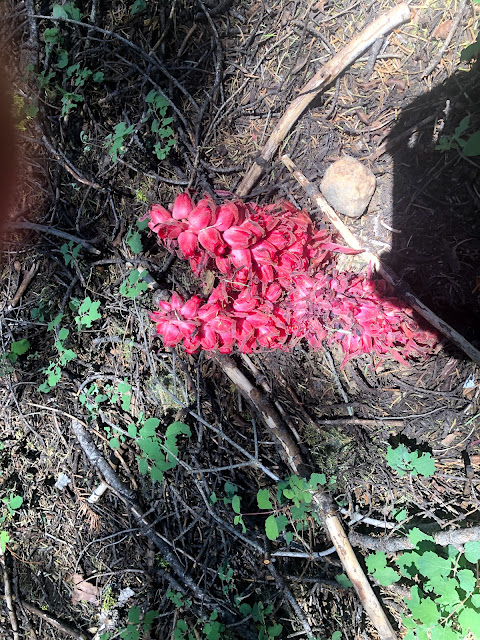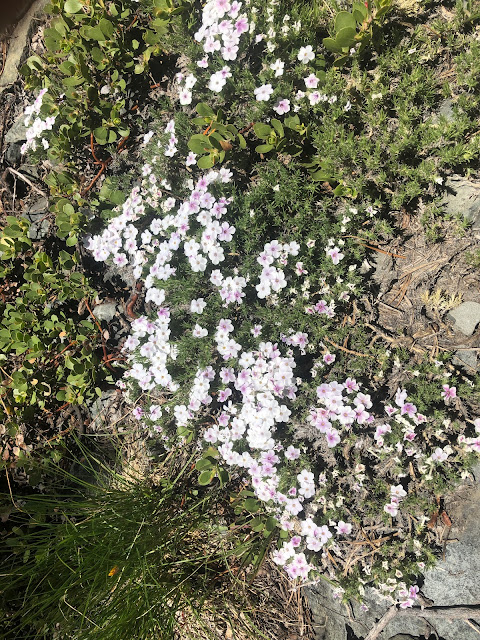With the 2020 summer hiking season having not worked out at all as I had planned (no Peru trip, no Corsica trip owing to covid, no Sierra High Route owing to fires) and the airwaves full of depressing covid, vaccine, and politics noise, I decided to go out one more time for a good long time. I headed to the Grand Staircase Escalante area in Southern Utah. The plan was to do a bunch of 3-8 day hikes in this area and as well as to scope out some details for a Hayduke hike I am considering for Spring 2021.
Boulder Mail Trail
This route connects Boulder, UT with Escalante, UT across the slickrock bench separating the two towns, crossing two major drainages along the way, the most significant being Death Hollow (see below). I read somewhere that the preferred way of doing this was from Boulder to Escalante as this was mostly going to be downhill. There is something to it, but there is a fair amount of climbing and descending to do regardless.
I tried to get a ride to Boulder with printed sign in hand from downtown Escalante and had absolutely no luck. It was as if people feared I’d be carrying some form of pestilence. How could that possibly be in Spring 2020?
Next morning I had better luck catching a ride from Hole in the Rock road. I was not exactly sure where I had to get off the highway and my hosts dropped me off much farther along than I needed to be. I hiked back along along the highway, back onto the bench. There is a road leading to Salt Gulch and Hells Backbone right around the Mile 93 marker. Take that, then take the first dirt road on your left for about 500 yds, cross the airfield (look to your left first) and you find yourself at the trail head.

Maybe this person should try lightweight backpacking and leave the kitchen sink at home
The single trail is somewhat ho-hum at first, but as you reach the Sweetwater Creek drainage it gets more interesting. You descend a minor slickrock face, cross the creek and work your way around a ridge. Here I camped for the night under a bunch of pinions and continued next morning on slickrock and through deep sandy stretches to reach the top of the cliff overlooking Death Hollow.
At the top of the descent to Death HollowThe excellently cairned route down to the creek has significant exposure and is not for those who are afraid of heights. It’s not as if you’d be falling straight off the cliff some 600 ft to your death, instead you’d be doing two or three bounces on your way down. The end result would be the same though.
Top photo: Descent to Death Hollow viewed from the bottom. Note the two trees in the center on the horizon. Bottom photo: Enlargement of the area around the two trees in the upper photo. For scale note the hiker immediately below the trees.
The ledges and ramps you walk are typical single track width or slightly wider, so no special acrobatics are required, but you would positively not want to stumble.
At the bottom you enter a shady oasis right by the side of the creek where you can take a rest before heading downstream to the location where the trail continues up the other side. This spot, another shady oasis, is marked by cairns and the trail climbs much less steeply and much more quickly out of the Death Hollow drainage. After some slick rock walking you again make your way through deep sand to a slickrock bench above Mamie Creek. I spent the night there in a little hollow in the slickrock shielded from the wind by a pinion tree. As I was having breakfast Andrew Skurka passed by with a client group, headed for Death Hollow and the Escalante river.
Above Mamie Creek
All along the way the trail runs along or crosses a telephone wire that connected Escalante Town and Boulder. This must have been some operation installing this thing and getting the wire across the Death Hollow drainage with its steep walls.
The descent to (dry) Mamie creek is steep but easy. You then hit a stretch of deep sand, followed by another slickrock wonderland, more sand and suddenly find yourself at the edge of the bench above Escalante. The descent is steep slickrock first and then a somewhat tedious stretch of trail where you have to watch your feet. Once you are down the slope you end up on a cairned trail that leads you to the Escalante river trailhead at the East end of town by the cemetery and the Hole in the Rock heritage site.
Two and a half glorious days with blue skies, temperatures in the sixties during the day and in the forties at night. Highly recommended.
Harris canyon - Fence canyon - Escalante - Harris canyon loop with side trip to Golden Cathedral/Neon canyon and Ringtail slot canyon
When I first learned about the Escalante National Monument on Jamal Green’s “AcrossUtah!” site I had read about the Golden Cathedral and Neon canyon as worthwhile destinations to visit. This year was going to be the time. I envisaged a round trip of some kind rather than an in-and-out type of trip. I settled on starting at the Harris canyon trailhead, making my way across the Buckaroo flat and the Allen Dump to the Egypt trailhead. From there I would be descending Fence canyon, head downstream to the Ringtail slot canyon, then to Neon canyon /Golden Cathedral. Heading up the Escalante river to the Harris canyon junction and up that canyon back to the trailhead.
On Google Earth I studied the flat comprising Buckaroo Flat and Allen dump above the Escalante river and thought that I should be able to make it, provided I was willing to carry enough water. It looked (and was) bone dry.
As I pulled into the small parking place at the trailhead I noticed a use trail at the back of the parking spaces which looked as if it was leading up to the flat area behind. This was indeed the case. After crossing two drainages and a fence on this use trail I stepped on a flat “meadow” consisting of more rocks than grass and started drifting East. This did not last long as a canyon with relatively steep walls blocked my drift East. I continued South until I reached a use trail continuing South in an area of rock outcroppings defining the West border of the canyon. As I continued in a Southerly direction on this use trail and was beginning to wonder where it was going (Hole in the Rock road?, Fifty Mile bench?), it suddenly veered East, crossed the rocky bottom of the canyon and continued straight East on the other side. The single track was easily followable and well defined for the entire time, no cairns necessary.
Eventually this use trail joined a dirt road which in short order reached a wide open meadow without the otherwise ubiquitous pinion and pine trees: Buckaroo Flat, which the road crossed. On the other side the road reached a maze of shallow drainages and split into several roads. I took the one heading North initially. After a short stretch heading West the road turned North again, then East to describe a half circle. At the end of that the well-defined road ended and continued as a much rougher ATV road for a short stretch before continuing as a single track. This track was rougher and in in places less distinct as the track I had been following earlier in the day. This was mostly a consequence of the ground being rockier than it had been earlier. You may lose the track for a moment, but you’ll find it quite easily again. As you continue East you see a ridge ahead and a canyon in front of it and wonder how you’ll be getting around that. It is entirely unproblematic if you follow the single track.
I hit the road crossing Allen Dump further South than I would have liked, I had hoped to reach it where it turns straight East, but that’s not how it ended up working out. I may have lost the trail and gotten stuck instead on a cattle trail. On the other hand as I walked up the Southern leg of the 4x4 road I did not see a trail coming in from the West. So a bit of a mystery, but certainly not a problem.
The East-facing part of the road runs along the crest above the Escalante drainage, then turns Southeast and ends when it joins the road leading to the Egypt trailhead from Hole in the Rock road. Another mile and you are there. All very unproblematic. The view from Egypt trailhead over to the other side of the Escalante drainage is great and worth it for that alone.
As several others I honored in the breach the prohibition against camping at the trailhead. I got up early and at dusk descended into the steep slick rock bowl below the trail head. After some mixture of slick rock and deep sand walking on more or less flat terrain you come out at the head of Fence canyon and descend into that on an intricate route using ledges and ramps. It’s well cairned (and needs to be) and easy to follow. The trail ends abruptly at the Escalante river. I sloshed downstream and then made my way through Russian olive and tamarisk mazes and over open meadows down to the Ringtail slot canyon.
Ringtail canyon
There is some scrambling to do, best without pack as the holes you have to crawl through are not that big. You can walk up the slot canyon for about 100 yds (maybe) where it gets wet and very shortly thereafter too narrow to continue.
I then walked back up the Escalante on the left bank as much as the geography allows in order to not miss the entrance to Neon canyon. It is marked by a rather wide cut in the Russian olive/tamarisk barrier immediately next to the river. The canyon is straightforward to follow and pretty. Then you suddenly stand in the Golden Cathedral. It really does live up to its name when the light is right. I was lucky to have had it to myself for about 20 min.
I then made my way upstream along the Escalante river switching banks as the use trails demanded. That too is pretty as you look at the canyon walls above you. Shortly before I hit the junction with Harris canyon I smelled cattle and camped for the night expecting to have to deal with bovines the next day as Andrew had warned me when I met him up on Boulder Mail trail and as Jamal has written.
However, I was in luck: no bovines in all of Harris canyon! I think that is probably a seasonal thing. When you hike Harris canyon in Spring you will encounter bovines in these low altitude grazing grounds whereas in October cattle are still kept at higher altitudes. I really enjoyed walking Harris, some very impressive alcoves, cliffs and natural bridges. There is always a relatively easily walkable foot trail on either or both banks. In the upper reaches you have to slosh for extended stretches through ankle deep water, but it’s really not an issue. At the very end you follow a dry stream bed and some use trails on the banks for about an hour or two, but it’s not deep sand, rather gravel mixed with sand and you can walk easily on it.
I think Harris canyon merits a two- or three-day trip for more exploration of the sights and sites.
Highly recommended.
Death Hollow
As I was crossing Death Hollow while doing the Boulder mail trail I had walked downstream a bit and found the canyon to be very pretty and worth a visit for its own sake. This assessment was supported by the fact that Andrew Skurka takes his groups down Death Hollow to the Escalante. Good enough for me!
I started at the Escalante river trail head on the East side of town by the cemetery and the Hole in the Rock heritage site. The trail heads in the direction of the gage site on the Escalante, but you hang left and follow a cairned trail below the escarpment to your right to the climb, the not that enjoyable piece of trail I had come down as I finished the Boulder Mail trail. Soon enough you will be out of the cobbles and ascend on slick rock. The outlook over the meadows and fields below in the direction of Escalante town is really quite striking.
I camped above Death Hollow under a cluster of pinion trees that provided good protection from the cold wind, which luckily died down in mid-evening. Next morning I descended to the Death Hollow drainage which in October is just marvelous! The cottonwoods are changing color, so you get this mixture of yellows and greens from the vegetation, the red rock from the canyon walls and the blue sky above. The dreaded poison ivy was not evident anywhere and the switching of banks along the creek was therefore straightforward. The water was never deeper than knee-deep.
Somewhere in upper Death Hollow
When my Gaia navigation informed me that I had about a mile to go to the junction with the Escalante river, I thought “That was easy”, but around the next corner I walked up to the narrows. “Cool” he thought until he came closer to the crux. Soon enough the three stages of dealing with hiking obstacles kicked in (same as with grief): anger, denial and acceptance.
Approach to Death Hollow Narrows (top) and the "business end" of the Narrows (bottom)
Anger: Who is the maroon who ordered narrows in this inconvenient place? You want to make me “work” before dinner?
Denial:”They”cannot possibly have me make my way through these narrows, there has to be a bypass! (Walks a quarter mile upstream to see whether he can get on the ledge on the right bank. No dice!). Inspects sloping slick rock on right bank right above the rapids: very steep, no way way to get up there. Inspects bench on left bank and steps on sloping slick rock: clearly steeper than the angle of repose, barely makes it back to less steep rock.
Acceptance: Okay, maybe I can push my pack in front of me on this little catwalk above the raging water. For the first time in a long time I do not pity, but rather envy the longitudinally challenged: I have a hard time fitting my 6’3" frame into this catwalk. About a yard in the ledge is only about half as wide as in the early part. Retreat!
Let’s see whether we can wade through the middle of the stream. The length of the narrow is divided into two pools, one blue-green and the second one blue in color: deep water! The first right at the beginning is 4-5 ft deep, so pack balanced on one's head one might be able to wade it, but then you have to climb over a barrier rock that separates pool 1 from pool 2. Too bad I am not an economist, they have the invisible hand of the free market in addition to the two hands that the rest of humanity has. But even if I could somehow climb over the barrier rock, the next pool is even deeper and how would I climb out of that pool without pulling myself up with two hands which I need to balance the pack. No go!
Ok, back to the catwalk: let’s try it without pack first. Much easier and I find a ledge below the water’s surface at the spot where the visible ledge narrows. I should be able to keep one foot on the ledge above water and place the other on the ledge deeper down. As I proceed, after about a yd of narrow ledge above the water, it widens again and I can stand up for a little bit to see whether I could place the pack on the ledge above and reach it from this location. Bingo!
The pack is well-behaved on the steep slope above that one spot where I can stand upright and the operation of pulling the pack down towards me comes off without a hitch. Luckily I have packed light, so that as I pull on the pack it does not build up momentum that gets me off-kilter as the weight shifts from being supported by rock to being supported by me. Then I duck walk through the rest of the cat walk (pardon the mix up of the animal metaphors) to where I can stand up for good and I am done.
This is a typical solo hiker problem as you do not have a second person that can hand the pack down to you, which would make this narrows easier to overcome (once you are over anger and denial). This took about 45 min, 30 of which were wasted on the anger and denial phases.
A quarter mile downstream one more dicey spot, a wall-to-wall pool of deep blue and hence deep water and a shoe-width sloping ledge under water on the right hand side. Two steps gets you across. That too passes.
I camp right at the junction with the Escalante at a well-used campsite, a choice I get to regret as the night goes on. The resident population of microbears is out in force and leaves nothing untried to get into my pack and into my food. I should have walked another 15 min and found myself a little-used site without a habituated population of mice.
Next morning it takes me about 4 hrs to walk upstream along the Escalante to the trail head. Pretty walk in the morning sun under towering canyon walls. I had hiked this part last year already, but I again enjoy it very much.
Overall verdict: highly recommended. Take your time and, unlike Lot, look back on occasion. The sights really do change dramatically. Or (the horror!) you have to come back and hike Death Hollow upstream.
Big Horn canyon to Zebra canyon and Tunnel canyon
Following a recommendation of Jamal Green’s I decide to visit Zebra canyon and the neighboring Tunnel canyon. There are two major avenues for getting there: either from Harris trail head or via Big Horn canyon. Since I have been to the former and do not know the latter, I chose Big Horn canyon for the approach. Access to Big Horn canyon is via the Spencer Flat road which takes off from Hwy 12 at mile marker 70 (coming from Escalante the highway climbs a hill with a 35 mile speed limit at the top, a sharp right turn follows, you pass a scenic point on the left and then the road makes a 90o turn left, descending to another 90o left turn. The unsigned Spencer Flat road takes off to the right just before this last 90o curve. The dirt road has various turn outs where people can park and camp. I choose one randomly, camp there for the night under some pinions and take off next morning.
I walk the road for about 20 min, cross a cattle guard and shortly thereafter one arm of Big Horn canyon (the middle one as it turns out) becomes evident to my right. As I head over there a minor use trail and some cairns appear. You scramble down and then walk in deep sand until you hit the first major dryfall, some 30-40ft in height. A bypass is evident and after a quarter mile you can scramble down to the drainage bed, which is filled with deep sand. As you grind along you arrive at dryfall 2, also very deep. There are bypass trails evident on either side. Take the one on the left bank. Trust me! This bypass is quite long actually.
Dryfall in upper Big Horn canyon
This walk around is longer than the first one, but reasonably easy to follow. As you enter the drainage you hit, you guessed it, deep sand. This lasts until you come to the slot canyon, which is real fun. There are three obstacles, chockstones and debris to overcome, but it’s fun. It’s also rather narrow and the walls are leaning in in places. Your backpack, if it’s bigger than a day pack, will be scratching along the walls in places. Your fancy Dyneema pack will not be happy. After leaving the slot and crossing some more deep sand you seamlessly enter Harris wash and head down to your left. Look out for use trails above the wash bed on either of the slightly elevated banks. They are infinitely easier to walk than the drainage bed with its deep sand. Crossings of the wash are not marked with cairns but you can pick them up easily enough.
On the flats above Zebra canyon. You get the idea
As you near Zebra canyon other members of the human species will be come notable and multiple paths converge on the entrance to Zebra slot canyon. It is filled with deep and breathtakingly cold water. This day is unfortunately not the right day to wade through, there are too many people and I don’t know how you’d squeeze by each other if one group comes down canyon while you are heading up canyon. I’ll be visiting again, via Harris canyon, with only a day pack.
I then make my way over to tunnel canyon over a bench that is fenced in. This bench has the Moqui marbles, which are really fascinating. These are round iron crusts the size between filberts and golf balls, some have seams that make the balls look like round clam shells.
Moqi marbles
The process by which these moqui marbles arise is not clear. It's their round shape that gives me the most headache. What's the thermodynamics of that? Luckily, people who have thought about that for much longer than I have do not know either. If you are curious:https://www.rocksandminerals.com/specimens/moqui.htm
I walk deeper into the bench and then head right where I end up at the upstream end of Tunnel canyon. I probe where I can drop in and eventually select a spot where I can slide inelegantly on my butt down the last two feet of very steep slick rock. Higher up in the valley were some pools with cool water, even this late in the year. The water is brownish and you only would have to carry the caffeine to add to it in order to make coffee. Tunnel canyon is very narrow and there are some pools to wade that come up to just above my knee at their deepest. Pretty easy.
I spend some more time with the moqui marbles and then head back up Harris canyon and camp right by the exit of Big Horn canyon. Next morning I visit the West fork of Big Horn canyon as recommended by Jamal, then head up Big Horn canyon again, this time bypassing the slot by walking on the bench above it on the right bank. I choose the East branch to get back to the Spencer flat road, but it has the same deep sand and a very high dryfall at the end that you bypass by walking up a steep slickrock ramp right next to it. Some exposure, but nothing to write home about. A somewhat longer road walk brings me back to my car.
This was not the best of my set of short hikes this year, but I also did not do it in the most efficient way (via Harris canyon). I had considered going via this route on my next long-distance adventure in Spring 2021. I am happy I explored it this Fall, that way I can strike that idea off my hiking plan. I can do without the slugging through deep sand when carrying a heavy pack and a couple of hundred miles under my belt already. Otherwise it’s pretty alright and what, after all, can beat spending time in Utah in October with clear blue skies, daytime temperatures in the 60's (and some nippy nights to be sure).
Lower Muley Twist canyon - Halls Creek-Baker Route-Stevens canyon route
I attempted a loop hike starting at the Burr trail switchbacks down beyond Halls Creek and then over to Stevens canyon via the Baker route. I had obtained the permit at the Escalante Interagency office but beyond that piece of paper I had received no useful information (the office was closed owing to covid and I counted my blessings that they at least issued a permit). I walked through Lower Muley Twist canyon, which is not quite as scenic maybe as the Upper Muley Twist canyon, but it’s cool enough.
Towering cliffs and giant alcoves keep you entertained, but there is also a fair amount of watching where you step as you walk through cobble fields. As I reached the Muley tanks I found out that they were dry and my entire water strategy depended on them not being dry. Not knowing where I might be able to find water along the route I decided to turn around.
As I headed North I picked up a use trail that stayed in the Halls Creek drainage rather than entering Lower Muley Twist canyon. It appears to be semi-official even through I can’t see it drawn on my maps. Whenever this trail crosses the drainage trail exits and entrances are marked with cairns. For the most part it is a compounded dirt trail that’s easier to walk than the canyon bottom of Lower Muley Twist.
Eventually the trail crosses the drainage and you approach a trailhead complete with outhouse. There I found a sign indicating that there was a 2-mile trail to Lower Muley Twist canyon. That sounded intriguing as you would have to cross one wall of Capitol Reef. Off I go!
First it’s a trail on red dirt and then you ascend a steep slick rock ramp at the end of which the fun begins: a convoluted route over slick rock with some exposure, significant exposure for short stretches. As the slope moderates deep sand awaits you for a stretch before you descend on ramps and ledges to the bottom of Lower Muley Twist canyon. As I am coming down I notice the signs indicating this route. I had not noticed them on my way down the canyon the day before, maybe because I had been watching my feet or because I was lost in thought or “thought”. From there it's about 3-4 hrs up to the Lower Muley Twist canyon entry near the Burr trail switchbacks.
I will try this again, getting my permit at Capitol Reef NP headquarters where they have the relevant information about water. It would also be possible to cache some water coming in from Halls Creek Overlook trailhead in case the Muley and Fountain tanks are dry. The walls of Halls Creek drainage are just a wonder to watch in the morning and at dusk, so much morphology, so much play of shadows and shapes. Alas it's a long haul back to the Burr trail switchbacks from Hole in the Rock road to close the loop and get back to the car. This covid year was not quite the year for a successful 40 mile hitchhike.
Halls Creek Narrows
This time then I actually drove to Torrey to the Capitol Reef NP headquarters to obtain my permit thinking that the NP rangers might possess some reasonably up-to-date information on the water situation. That was indeed the case.
With permit in hand I drove some 13 miles to the jct with Notom Rd. and then entered the park via from the North. It’s asphalted at first but as you enter the park proper it becomes a gravel road, more an extended washboard that tests the seat of the fillings in your teeth and the solidity of the synapses in your brain. But that too passes, eventually. At a road junction with a road leading to the Lower Muley Twist trailhead, turn left and continue a short zig-zag section through the mudhills before you leave the NP. The road is asphalted again as it leaves the park and heads South. It then swings East climbing out of a shallow bowl and continuing East. At a junction with a dirt road straight ahead the asphalted road swings South and you follow the asphalt road for another mile where you turn off to the right side of the road at a marked parking lot. You could continue for another 3 miles on a dirt road but that one is pretty rough, so you need to make a call on your vehicle’s capabilities. I typically play that carefully as getting a tow out of a location like that is $$$$$$$.
I walked the three miles to the trailhead proper and then descended along the cairned trail to the Halls creek drainage. The maps suggest a length of this trail of 1.2 miles and a drop of 800 ft. In reality there is a lot of contouring with little elevation gain/loss with mixed in sections of steep descents/climbs. This is not an entirely gentle affair.
I camped in a pinion cluster at the bottom and next morning followed a well-trodden path South. It’s a mixture of walking on compressed dirt and through deep sand, so a little bit more strenuous than the distance would suggest. At the Northern junction of Halls Creek with the Hall Divide I decided to not walk Halls creek in a downstream direction as it was too early in the morning and I hoped that by walking in a South to North direction that the narrows might be somewhat warmer in the PM (It was early November, remember). The trail across the Halls Divide is a bit rough, but you get to see parts of the old wagon trail that the pioneers cleared/built. Whenever I see these remnants from the time of the settlers I am struck by how tough these men and women must have been. Let's not even talk about the Paiute, the original inhabitants of this area.
There is no particular indication of where to leave the trail but monitoring my progress on Gaia GPS I had no problem finding the Southern end of the narrows. There is a slick rock bench on the left bank from which you can climb down to creek-level and then you find a breach in the reeds and the tamarisk that allows you to find a kind-of-trail that leads you upstream.
The narrows start with a slot portion and feature a long and deep pool of turbid blue-green water. It was time for anger-denial-acceptance again. I waded into the water up until it reached well above my knees and at that point the water was darker (= deeper) ahead of me. “Who ordered this nuisance to be placed here”, “The rangers only talked about wading through water to my mid-thigh”. During the denial phase I tried to climb up on the slanted slick rock on the right bank but it was just a tad too steep for my shoes to hold. As the acceptance phase kicked in I dumped my pack and waded into the pool. When the water was right at my arm pits I was still going down and I was gasping for air since the water was so friggin cold. I was not confident that I could walk through this pool without having to take my head under water. It was also not clear that the bottom of the pools did not offer some nasty surprises (quicksand anybody?). What to do? Swimming with my pack on my head was not my number in Circus Roncalli, so that was not an option. After a brief inspection of the bench above the left bank it was clear that the solution did not lay there. So back to the right bank and as in Death Hollow try things out without the pack. This time I was successful with holding myself on the sloping slick rock shelf by using my forearms and hands as friction brakes and then robbing upwards/forwards. Soon I could turn myself around and stand up. Walking around the the slight curve that obscures possible down climb sites from the bench I soon spotted a place where I might get down beyond that miserable pool below. The descent from this bench at the Southern end to repeat the entire sequence plus pack was "interesting" in the Chinese curse sense "May you live in interesting times". But it all came together, eventually.
On the next sunny bench I warmed and dried myself, put on another layer of clothing as the Narrows are in deep shade most of the time and noticeably cooler than the surrounding area. It’s an impressive place that defies my photographic skills as the enormous scale of the walls towering above you is difficult to capture without a second person being around that one can place in the picture to give a reference point.
I surely can understand why it is a popular destination and am happy that it takes some effort to get there so that it does not turn into Coyote gulch. As it was I saw six people in four groups while walking through the narrows and encountered one group of four women heading there as I was walking out. That’s a level of “crowd” that I can deal with.
After exiting from the narrows I found myself a little mount in a wide section of Halls Creek drainage so that I could have some evening sun and a chance of catching some morning rays as well. It was getting really cold every night (water bottles frozen every morning) and any little bit of warmth in the morning was very much appreciated.
The rest of the return trip was uneventful. Highly recommended. Bring lots of water. The water in Halls creek is a tad scummy and algae laden. Depending on your water purification method, this might cause some problems.













